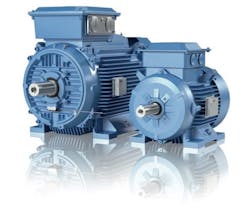Wearable Sensors for Low-Voltage Motors
We’ve all been hearing a lot about “wearables”—devices people can wear that track and deliver data in real time about their actions. Fitness trackers and smart watches are the two most common examples. But wearable devices aren’t just for humans any more.
ABB recently announced that it is introducing a new smart sensor designed to pick up signals from low-voltage (LV) motors to provide regular and accurate measurement of the motor’s key condition parameters. Data collected by the sensor are transmitted wirelessly to secure, cloud-based ABB servers.
Users have two options for transmitting data from the sensors to the servers: 1) on-request transfer using a smartphone; and 2) gateway-based automatic communication. Small sites with only a few motors will likely use the smartphone option, while larger sites will prefer the gateway version since this eliminates the need to walk by the motors with a smartphone for data transfer purposes. A Bluetooth Smart wireless communication interface on the sensor is used to transmit data to the smartphone or gateway. ABB said the sensor units will have a transmission range of up to 50 meters and can transfer1 MB of data per month.
Mounted on the motor frame, the wireless sensors require no additional cabling. Also, because the sensors are battery powered, there is no need to have an electrical connection between the smart sensor and motor. ABB points out that this lack of direct connection between the sensor and motor means there is “no way unauthorized parties can gain control of the motor through the [sensor] unit.”
The sensors can be mounted on new motors or retrofitted on existing motors, whether the motors are made by ABB or not. The company does note, however, that “additional motor details need to be configured in the unit during installation” if it is not an ABB motor.
The smart sensor’s full functionality is currently available for three-phase squirrel cage induction motors connected to a standard 50/60 Hz power supply. The sensors can also be used on variable frequency drive (VFD)-controlled motors with limited functionality. ABB says not all the sensor’s features are yet available with VFD-driven motors or those with intermittent duty cycles.
The service provided by ABB around these sensors includes full data analysis. According to the company, data gathered by the sensors are time-stamped for trend analysis and processed in the server using proprietary algorithms developed by ABB. Some primary analysis of the acquired data is performed in the sensor using the sensor’s built-in MEMS (micro electro-mechanical system).
As for security, data transfers from the sensors to the servers reportedly use industry standard encryption protocols. ABB states that data is stored in an encrypted form in the cloud, and its portal uses role-based access control to make the data available to the customer in a secure manner.
Beyond the intriguing, Internet of Things aspects of this LV motor sensor, the real aim of this offering is to bring condition monitoring to LV motors—a class of devices not commonly included in larger plant asset management initiatives. ABB says this new sensor will enable “plants to bring their entire LV motor fleet into the scope of predictive maintenance.”
Companies in different industries in the U.S. and Germany have piloted the smart sensors. ABB says it plans to start taking beta customer orders for these sensors at Hannover Messe 2016, April 25-29.
About the Author
David Greenfield, editor in chief
Editor in Chief

Leaders relevant to this article:
